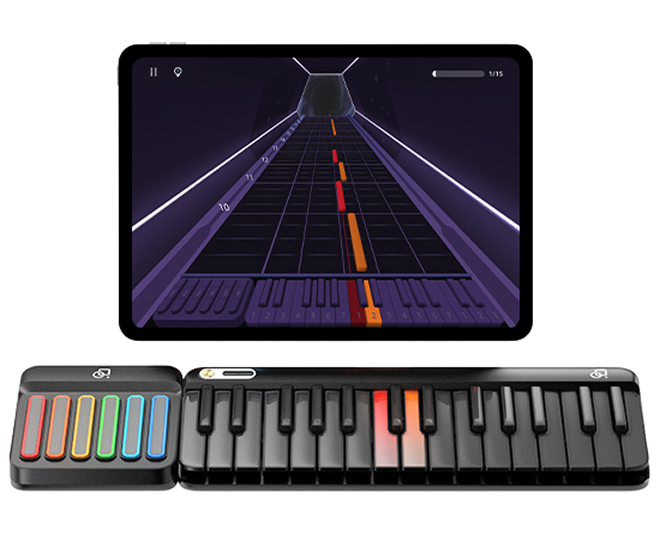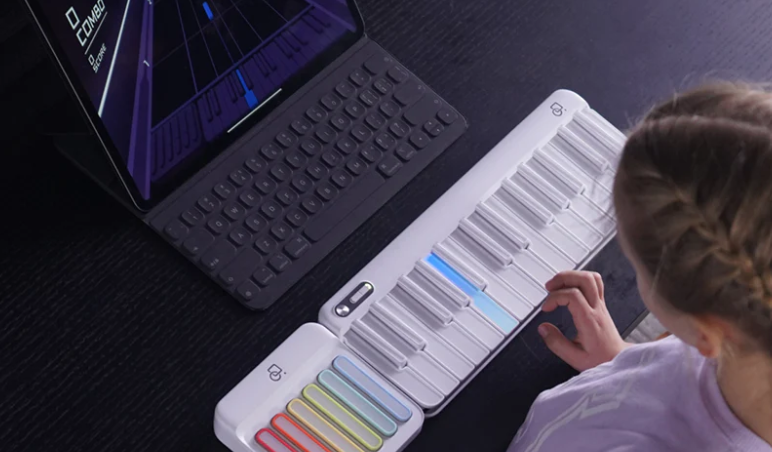
The dream is simple: sit at the keys, play your favorite song, feel that goose‑bump little rush. The question that stops many beginners cold is how much that dream is going to cost. Should you buy a traditional piano, a mid‑range digital piano, or grab a modern smart keyboard piano such as the Smart Keyboard?
Learning any instrument involves more than swiping a credit card once. For clarity, we’ll track spending inside four buckets:
Few moments rival pressing a grand’s keys and feeling strings vibrate under the lid. Those vibrations, however, come at a respectable cost.
Traditional students usually pair the acoustic with a private teacher.
Five‑Year Snapshot (Upright Student)
|
Item |
Cost |
5‑Year Total |
|
Used Upright Piano |
$3,500 |
$3,500 |
|
Tuning (2×/year @ $125) |
$250/yr |
$1,250 |
|
Misc. Maintenance |
– |
$500 |
|
Private Lessons (avg $50/lesson) |
$2,400/yr |
$12,000 |
|
Sheet Music |
$75/yr |
$375 |
|
Moving & Humidity Control |
– |
$800 |
|
Grand Total (5 yrs) |
≈ $18,425 |
Steep, yes, but many families see it as a long‑term heirloom investment plus structured musical education.
Digital pianos chase hammer feel and realistic samples without wood, strings, or yearly tunings.
Financing plans, if needed, run shorter because overall price is lower.
Option A: keep private teachers. Option B: blend teachers with apps such as Flowkey, Simply Piano, or Playground Sessions.
Five‑Year Snapshot (Mid‑Range Console + Hybrid Lessons)
|
Item |
Cost |
5‑Year Total |
|
Digital Piano |
$1,500 |
$1,500 |
|
Stand & Bench |
$180 |
$180 |
|
Occasional Service |
– |
$150 |
|
App Subscription |
$150/yr |
$750 |
|
Monthly Teacher Check‑in (1 × mo @ $40) |
$480/yr |
$2,400 |
|
Sheet Music |
$50/yr |
$250 |
|
Grand Total (5 yrs) |
≈ $5,230 |
That’s roughly 72 % lower than the upright track while still delivering authentic weighted keys.
Now to the new kid on the block: the smart piano keyboard. These instruments, led by brands like PopuMusic, inject LED guidance, gamified lessons, and social‑media‑ready performance features into a portable shell.
Five‑Year Snapshot (Full PopuPiano Set)
|
Item |
Cost |
5‑Year Total |
|
PopuPiano Full Set |
$600 |
$600 |
|
Sustain Pedal |
$30 |
$30 |
|
Replacement Battery (yr 4) |
$25 |
$25 |
|
Optional Song Packs |
$20/yr |
$100 |
|
Bench or Stand (if desired) |
$75 |
$75 |
|
Grand Total (5 yrs) |
≈ $830 |
|
Five‑Year Learning Path |
Instrument & Gear |
Maintenance |
Lessons / Apps |
Total |
|
Upright Piano + Traditional Lessons |
$3,500 |
$2,550 |
$12,375 |
≈ $18,425 |
|
Digital Piano + Hybrid Lessons |
$1,680 |
$150 |
$3,400 |
≈ $5,230 |
|
PopuPiano Smart Keyboard |
$705 |
$25 |
$100 |
≈ $830 |
Even accounting for optional accessories, the smart keyboard track is the clear budget champion.
A $10,000 grand that collects dust is a worse deal than a $600 smart board that sees daily play. Light guides, instant feedback, and low intimidation scores often keep newbies glued to the keys longer.
Weighted hammer action remains critical if you aim for advanced classical repertoire. Smart keyboards and unweighted boards build coordination and ear training but eventually you’ll need heavier keys to develop nuanced dynamics. Luckily, PopuPiano’s expansion path plus easy MIDI output lets you keep it as a composing tool even after you upgrade.
Want to jam at a friend’s barbecue? You’re not fitting an upright into the hatchback. A digital piano might squeeze in. A smart keyboard slides under your arm and still leaves room for chips.
PopuPiano outputs MIDI over USB‑C or Bluetooth, doubling as a controller for GarageBand or Ableton. That’s a workflow perk many acoustic players pay extra microphones and interfaces to replicate.
|
Persona |
Budget Level |
Ideal Gear |
Why |
|
College student in a dorm |
Under $1k |
Smart keyboard |
Low price, headphone‑friendly, fits in a drawer. |
|
Parent with young kids & long‑term lessons plan |
$2k–$4k |
Digital piano |
Weighted keys, headphone practice, no tuning. |
|
Retiree fulfilling a grand‑piano dream |
$10k+ |
Acoustic upright or baby grand |
Rich tone, furniture aesthetics, lifelong goal. |
|
Bedroom producer / YouTuber |
$1k |
Smart keyboard + DAW |
LED looks on camera, MIDI for tracks, tiny footprint. |
Q: Will a smart keyboard teach proper finger strength?
It builds coordination and note accuracy first. You can add a weighted controller later; by then reading and rhythm will already feel natural.
Q: Do I need an 88‑key piano keyboard to start?
No. Most beginner courses stay under 61 keys for months. Expanding once you tackle bigger pieces keeps early costs tame.
Q: How long before I’d “outgrow” a smart piano keyboard?
Depends on goals. PopuPiano’s modular design grows to 43 keys. Many casual players never feel limited; classical track students often upgrade around year two.
Can I combine paths?
Absolutely. Plenty of learners begin on a smart keyboard, upgrade to digital piano for weighted action, then keep the smart board as a travel companion.
Numbers tell one part of the story, daily joy tells the rest. If your budget is tight or you’re unsure how deep this hobby will stick, a smart keyboard offers the least‑risk entry with surprisingly rich rewards. For those sure about a lifetime journey into Chopin and Rachmaninoff, the heftier invest‑up‑front routes add authenticity—and cost.
Either way, carve out a practice corner, schedule regular playtime, and choose the setup that makes you grin every time the power button glows. Honestly, that’s the best investment you’ll make this year.
Ready to crunch your own numbers? Pull out a notepad, list today’s goals, and see where that Smart Keyboard or a solid digital piano fits. Then dive in. Your first chord is waiting.
Leer más

Keyboard or Digital Piano? What Beginners Need to Know Before Buying
Walk into any music shop—or scroll through a few online listings—and the words keyboard and digital piano start blurring together. Both have black‑and‑white keys, both promise “great piano sound,” ...

Best Keyboard Picks Under 500 USD That Are Fun for Beginners and Families
Scrolling through online music shops can feel like falling into a black hole of specs and sales banners. If your budget tops out at fifty dollars—and you’re hunting a first keyboard for yourself, t...